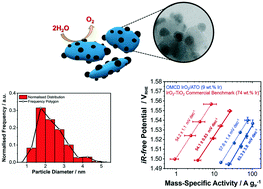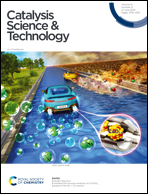Organometallic chemical deposition of crystalline iridium oxide nanoparticles on antimony-doped tin oxide support with high-performance for the oxygen evolution reaction†
Abstract
The design of efficient, robust catalytic materials for the anodic evolution of oxygen in proton exchange membrane water electrolysers remains a great challenge to be overcome for the commercialisation of this promising hydrogen generating technology. In the present work, we demonstrate a simple, one-step organometallic chemical deposition (OMCD) of IrO2 nanoparticles onto Sb-doped SnO2 (ATO) high-surface area support. The resulting IrO2/ATO electrocatalyst was characterised using high-resolution scanning transmission electron microscopy (HR-STEM) and X-ray photoelectron spectroscopy (XPS) to develop an understanding towards the structural and chemical properties of the prepared materials. The OMCD method produced crystalline IrO2 nanoparticles of 2.3 ± 0.7 nm that were uniformly dispersed over the ATO support surface. Most interestingly, structural metal–support interactions were observed in the form of epitaxial anchoring of IrO2 nanoparticles on the ATO support. These characteristics yielded outstanding oxygen evolution performance: a 7-fold increase in Ir mass-specific activity was observed compared to an IrO2–TiO2 commercial benchmark, in combination with excellent stability of our crystalline IrO2.



 Please wait while we load your content...
Please wait while we load your content...